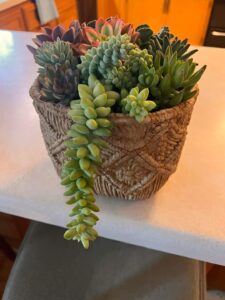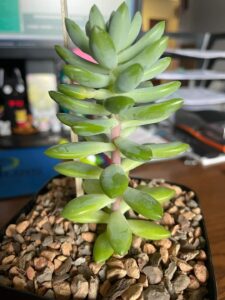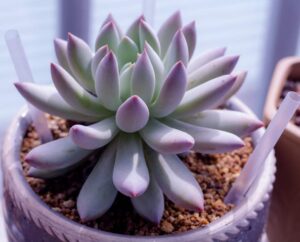Succulent plants come in unique, diverse colors, textures, sizes, and shapes and are perfect for adding a bit of interest, drama, and beauty to your interior décor. However, you must keep them alive and thriving to enjoy the benefits and appeal, so proper care is vital.
You can use succulents as tabletop decorations, in terrariums, or as part of your indoor garden display. These plants will also help purify the air, increase humidity, and improve your overall well-being.
Although succulents are low maintenance, you need to know how to grow them and avoid killing them. So, to aid your project, here’s a beginner’s guide on how to care for succulents indoors.
How To Care For Succulents Indoors
When it comes to caring for succulents indoors, you must provide the things they require to thrive. These are suitable soil, proper watering, bright and indirect light, warm temperatures, regular pruning, and some fertilizer during active seasons.
Furthermore, you may need to repot your succulents if they outgrow their containers. The sections below explore everything you must know to care for indoor succulents properly.
Also Read: Succulents that are safe for cats and dogs
Choosing The Right Soil
The suitable soil will help your succulents grow well and stay healthy, so you must choose carefully. Typically, these plants prefer well-draining soil that allows an easy water flow and doesn’t retain moisture for too long. Therefore, soil from your garden or yard may not be ideal for growing succulents indoors.
Garden soil is usually too heavy for succulents and may carry plant diseases or pests. When choosing a soil mix for your succulent plants, avoid heavy, clay-like soil because it usually retains moisture for too long and leads to root rot.
Below are the best options to choose from:
a) Commercial Succulent Soil
You can buy soil mixes explicitly formulated for succulents from a garden center or online. These mixes usually contain a combination of perlite, sand, and coconut coir or peat moss.
This soil is perfect for succulents because it offers good drainage, aeration, and a balanced pH. Moreover, it is often sterilized to kill bacteria, fungi, and pests, and you can rely on the consistency of the soil in each bag. Also, this is a convenient option.
Related: Easiest Succulents To Grow Indoors For Beginners
b) DIY Succulent Soil Mix
Instead of buying soil for succulents, you can make your own mix. Do so by mixing equal parts of sand, perlite, and potting soil to create a mixture that will give your plants good drainage and aeration.
The biggest reason to make your own succulent soil mix is the freedom to customize the soil to suit the specific needs of your succulents. Other benefits include cost-effectiveness, using organic materials, and you may already have the ingredients.
c) Cactus Soil Mix
A cactus soil mix is also a suitable option, as it is well-draining and ideal for succulents. While it is similar to succulent soil, it may contain more sand and less peat moss or coconut coir.
Also Read: Types of Purple Succulents
Selecting The Right Container
Choose the right container for the plants to help your succulents thrive and keep your home looking good. Consider these during selection.
i) Size
Since your succulents will grow bigger, choose a container slightly bigger than the plant’s root ball to accommodate and facilitate growth. However, it should not be too long to prevent the soil from retaining excess moisture, leading to root rot.
Also Read: Hanging Succulent Planters
ii) Drainage
As mentioned earlier, succulents require well-draining soil, so the container must contain drainage holes to ensure excess water flows out. If you find a container you like but doesn’t contain drainage holes, drill them yourself.
iii) Material
Containers come in different materials, including plastic, ceramic, terra cotta, or glass. For lightweight and easy-to-move-around containers, pick plastic and ceramic. On the other hand, if you want a porous container that can wick moisture away, choose terra cotta pots.
You may be tempted to get glass containers because they are attractive. The problem is they may not provide the best drainage for succulents.
iv) Shape
Wide, shallow containers are ideal for succulents with shallow root systems, such as haworthias or lithops. On the other hand, deep-shaped containers are better suited for succulents with deeper root systems, such as cacti or agaves.
v) Aesthetics
While you should prioritize the well-being of your succulent when choosing containers, do not disregard aesthetics. Ensure the containers you pick complement your home décor and enhance your succulent plant’s beauty.
Related: Why is my succulent dying?
Lighting Requirement for Indoor Succulents
Since succulents are naturally desert plants, they love sunlight and require bright, direct light to grow and thrive. Part of caring for your succulents is ensuring they get sufficient lighting. However, these plants can easily get sunburned, so don’t leave them in summer’s scorching sun for too long.
Also Read: Best full sun succulents for outdoors
Your succulent plants can get light from artificial or natural light.
Natural Light
Place your succulents near a south or east-facing window where they can receive direct sunlight for at least six hours daily. Be sure to rotate the plants every few weeks to ensure they receive even light and grow evenly.
Artificial Light
If you don’t have access to natural light or your indoor space doesn’t receive enough sunlight, use artificial light to supplement your succulent plants’ light needs. LED grow lights offer a full light spectrum and energy efficiency; that’s why they are famous for indoor succulent growers.
Position the grow light at the appropriate distance from your succulent plants. The ideal distance will depend on the light intensity and the succulent plant type. However, keep this distance 6 to 12 inches above your succulents.
Keep in mind that succulent plants need some darkness each day to rest and recover. Therefore, set the time on your artificial light to ensure the plants receive 12 to 14 hours of light and 10 to 12 hours of darkness daily.
Temperature And Climate
Succulents are adapted to arid and semi-arid climates and generally prefer warm temperatures, low humidity, and good air circulation. To help your indoor succulent plants thrive, provide them with the right temperature and climate conditions.
Below are the climatic conditions your succulent plants will need.
a) Temperature
Most succulents enjoy temperatures between 60°F to 80°F (15°C to 27°C). However, some species tolerate lower temperatures of 40°F (4°C) or even up to 90°F (32°C). Therefore, knowing the species of succulent plants you have is helpful.
When it comes to the cold seasons, your succulent plants will survive and tolerate cooler temperatures. However, protect them from freezing temperatures because it can cause plant stress and damage. Ideally, keep the temperature above 50°F (10°C).
Succulent plants can tolerate higher temperatures, so summer should not present significant issues, but remember, extreme heat can cause stress and damage. Therefore, protect them from excess heat by moving them to a cooler location or providing shade if the temperature exceeds 90°F (32°C).
Moreover, succulents can adapt to temperature fluctuations, but sudden temperature changes can stress the plants. Therefore, avoid placing your succulent plants near drafty windows or doors, and protect them from extreme temperature changes.
b) Humidity
Succulent plants’ natural habitat is arid and semi-arid climates, often with low-humidity environments. High humidity can cause fungal infections in succulents and cause root rot. Therefore, keep the humidity level between 30% to 50%.
c) Air Circulation
Avoid moisture buildup and lower fungal infection risks by facilitating good air circulation. Do this by placing your succulents in a well-ventilated area, opening windows, or running a fan.
d) Seasonal Changes
Although succulents can adapt to seasonal temperatures and climate changes, sudden changes or extreme conditions can stress the plants. You must also protect your succulents from freezing temperatures. Do so by providing enough sunlight, using a humidifier, adjusting watering frequency, keeping them away from windows or doors, and even moving them to warmer areas.
How To Water Succulents Indoors
You don’t need to water succulent plants as much as normal plants since they are conditioned for arid areas. However, they still require water, especially during active growing seasons. Succulents thrive in well-draining soil, the soil type that will dry out between watering.
Also Read: How do you tell if you have overwatered your succulents
Therefore, water the plants only if the soil is entirely dry. Before watering your succulent plants, check the soil’s dryness by sticking your finger into the soil, making sure your first knuckle is inside the soil. Water them if the soil feels dry.
Since succulents go dormant in winter, they require less water, so reduce your watering routine during this time.
When watering your succulent plants, here’s what to do:
- Water deeply and let the water penetrate and soak into the soil. Avoid misting because it causes leaf rot.
- Ensure the water reaches the plant’s root zone. You can water your succulent plants from the top or bottom.
- When watering from the top, water the soil around the plant base without wetting the leaves or stem.
- When watering from the bottom, place the container in a tray with water; the soil will absorb the water.
- Also, do not overwater succulent plants since this is among the most common causes of problems with succulent plants. For instance, too much water can cause root rot and plant death. The soil must be fully dry prior to watering.
Fertilizing Your Indoor Succelents
Succulents don’t require frequent fertilization, but providing the right nutrients can help them grow and thrive. Fertilize your succulent plants in summer and spring when actively growing. On the other hand, avoid fertilizing in winter when the plants are dormant.
Also, apply fertilizer sparingly and avoid overfertilizing because it can make succulents grow too quickly and become weak and leggy. When it comes to proportions, make sure the fertilizer has a 5-5-5 or 10-10-10 NPK (nitrogen, phosphorus, and potassium) ratio. Furthermore, dilute the fertilizer so it’s not too concentrated.
Related Post: Common Problems With Succulent Propagation
The soil should also be moist before applying fertilizer, so lightly water your succulent plants first to prevent root burn but ensure it’s not waterlogged. While you can use commercial fertilizers, their organic counterparts provide slow-release nutrients and can improve soil structure and fertility.
Propagating Succulents
Succulent plant propagation provides a cost-effective and fun way to increase the number of your plants. To do so correctly, choose the right plants to propagate, method, and time. The parent plant must be well-established and at least six months old.
Propagate your succulents when the plant is actively growing (early summer or spring). Regarding the method, you can either choose dividing or stem or leaf cuttings.
For stem or leaf cuttings, use a sharp, clean knife or scissors to take out 2- to 3-inch-long leaf or stem cutting from the parent plant. On the other hand, if you go with dividing, divide the plant into sections with at least one stem and a healthy root system. After that, let the cuttings callus before planting.
Common Succulents Pests And Diseases
Succulents may be disease-resistant but aren’t immune to pests and diseases. The common ones are mealybugs, leaf spots, scale insects, root rot spider mites, and powdery mildew. Monitor your succulents for pests and diseases, and treat them with fungicides, insecticidal soap, 70% isopropyl alcohol, or neem oil but strive to prevent them.
Potting And Repotting
Generally, you should repot your indoor succulents every 1 to 2 years, depending on their growth rate and size. These signs will guide you to know when to repot your plants:
- Check the roots to see if they grow out of the succulent container’s drainage holes.
- If the soil in the pot is parched and compacted, it indicates that your succulents need more space to grow.
- If your succulent is leaning to one side or appears top-heavy, the roots are not getting enough support from the current pot and need to be repotted.
Choose a slightly bigger container than the current one and choose a well-draining soil mix. Then, let the plants settle into their new pots for a couple of days before watering.
Final Remarks
Numerous succulents, including Aloe Vera, Haworthia, Echeveria, Gasteria, Crassula Ovata (jade plant), and Kalanchoe, thrive indoors. However, despite being resilient, these plants will suffer and eventually die without proper care. This guide provides essential details for caring for succulents and is quite beneficial, especially to beginners.
References
Texas A&M University – How To Care For Succulents
Michigan State University Horticulture Gardens – Growing and Enjoying Succulent Plants
University of Minnesota Extension – Cacti and succulents

Hey there, fellow plant enthusiasts! I’m Rachel, the green-thumbed writer behind Rooted In Garden. With a deep-rooted love for all things botanical, I’ve made it my mission to help you cultivate a thriving collection of houseplants. As a devoted plant parent myself, I understand the joys and challenges that come with nurturing these leafy wonders. Whether you’re a succulent aficionado, an orchid enthusiast, or simply adore all potted flora, join me on this journey as we explore the secrets to growing and caring for our beloved green companions. Together, let’s create a flourishing oasis indoors.



